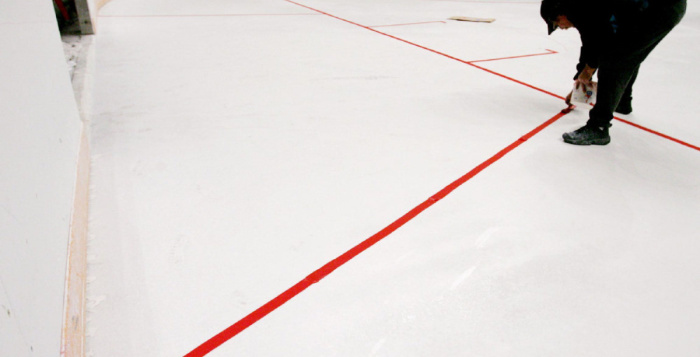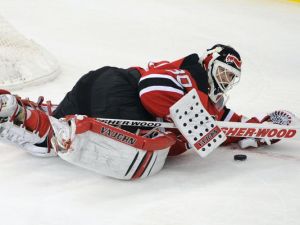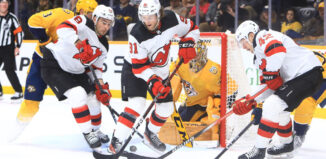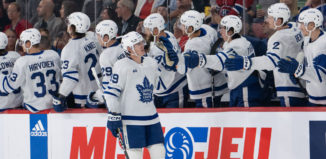The History of the Trapezoid
(photo: Paul Sakuma / AP)
Last week, the NHL announced rule changes for the 2014-15 season. One rule that was updated was the goalkeeper’s restricted area, Rule 1.8, which has a relatively short history. In order to fully understand the impact and significance of the rule change, let’s take a look at the rule, how it came to be, and its history to-date.
The designated area in which a goalkeeper can play the puck behind the net is aptly and commonly called the “trapezoid.” This area started six feet from each goal post; now, with the updated rule, the area is extended to eight feet from each goal post. From those two points, a line extends to the boards, thus creating the trapezoid-shaped area in which a goalkeeper can play the puck. Goalkeepers are limited to this area behind the net and theoretically keeps them from making defensive plays, such as passing to a teammate in the corner (the forbidden area outside of the trapezoid) or clearing the puck out of the zone during an attack, essentially becoming a bonus sixth skater. After the American Hockey League’s testing of the proposed trapezoid area, the rule was enacted in the 2005-06 season.
During the 2011 NHL Research and Development Camp, the trapezoid was removed and went back to pre-2005 times to experiment whether players could adapt to the older rule and if there was still a goalkeeper’s advantage. But just as the camp’s title implies, this was for research and development, and as Shanahan noted, “It’s what many companies do, what many corporations do. That’s what we’re doing. It’s not a knee-jerk reaction to anything that we feel is wrong with the game.” Obviously the trapezoid remained after the R & D. And most recently, in its nine-year existence, two more feet were added to the area for the 2014-15 season, thus enabling even more space for goalkeepers to play the puck. Is the extension a compromise between having the trapezoid and eliminating it altogether? Does the trapezoid add interest to the game, is it a distraction, or is it completely useless?
Today, the expansion is great news for goalkeepers with good puck-handling skills. But back when the rule was first introduced, it was bad news for Martin Brodeur, the famed New Jersey Devils’ goalkeeper for whom the rule is supposedly inspired by.
Brodeur’s perspective on the rule: “Now I have to sit and watch all the time. It’s dangerous.”
(photo: Bill Kostroun / AP)
In the photo, you see Brodeur saving a puck from his net, almost on the boundary line between the allowable and forbidden areas.
Brodeur and other goalkeepers might have been able to “rescue” teammates by obtaining the puck and clearing the zone in the otherwise forbidden area; on the other hand, he did say giving goalkeepers all this added flexibility on the ice opens up room for mistakes, and might prevent them from their one job: protecting the net. He called it “havoc” when goalkeepers are given the freedom to roam.
In a way, the updated rule is a compromise – the trapezoid area is widened by two feet, therefore allowing more puck-play action for goalkeepers, while also keeping the “forbidden” area so that goalkeepers will stay in their net and not necessarily skate around with the puck and try and make plays.
A goalkeeper can and will make defensive plays, but because the space is limited, it shows their athleticism. In the pre-2005 world where no trapezoid existed, it’s worthy to note that because they are protected by interference rules, goalkeepers might have used those rules to their advantage behind the net, essentially being protected.
It’ll be interesting to see what the additional two feet will add to the sport, if anything, and hear feedback from goalkeepers. All eyes on Brodeur!
















[…] forcing Stalock to play the puck and clearly take advantage of the additional 3 feet in the trap, one of the new rules for the 2014-15 season. Sharks’ Adam Burish closes his hand on the puck, which forces a power play opportunity for […]